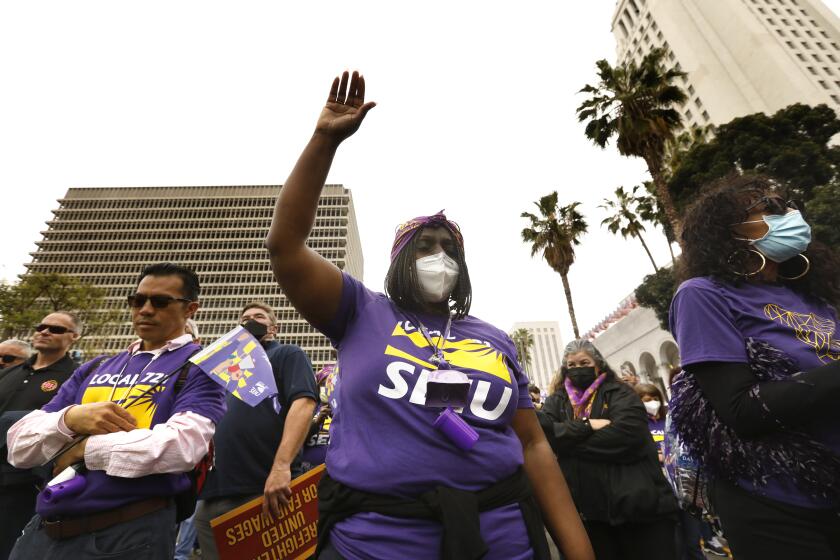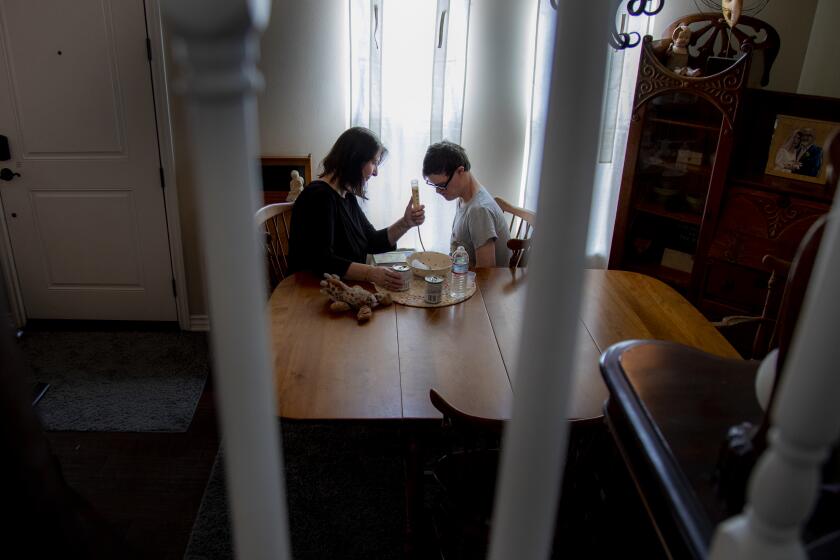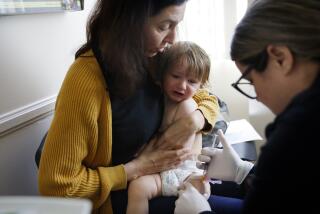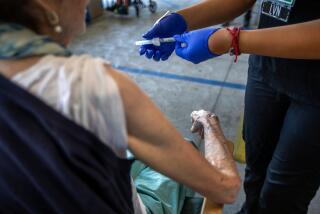The push to get children vaccinated is stalling. It poses new COVID-19 dangers
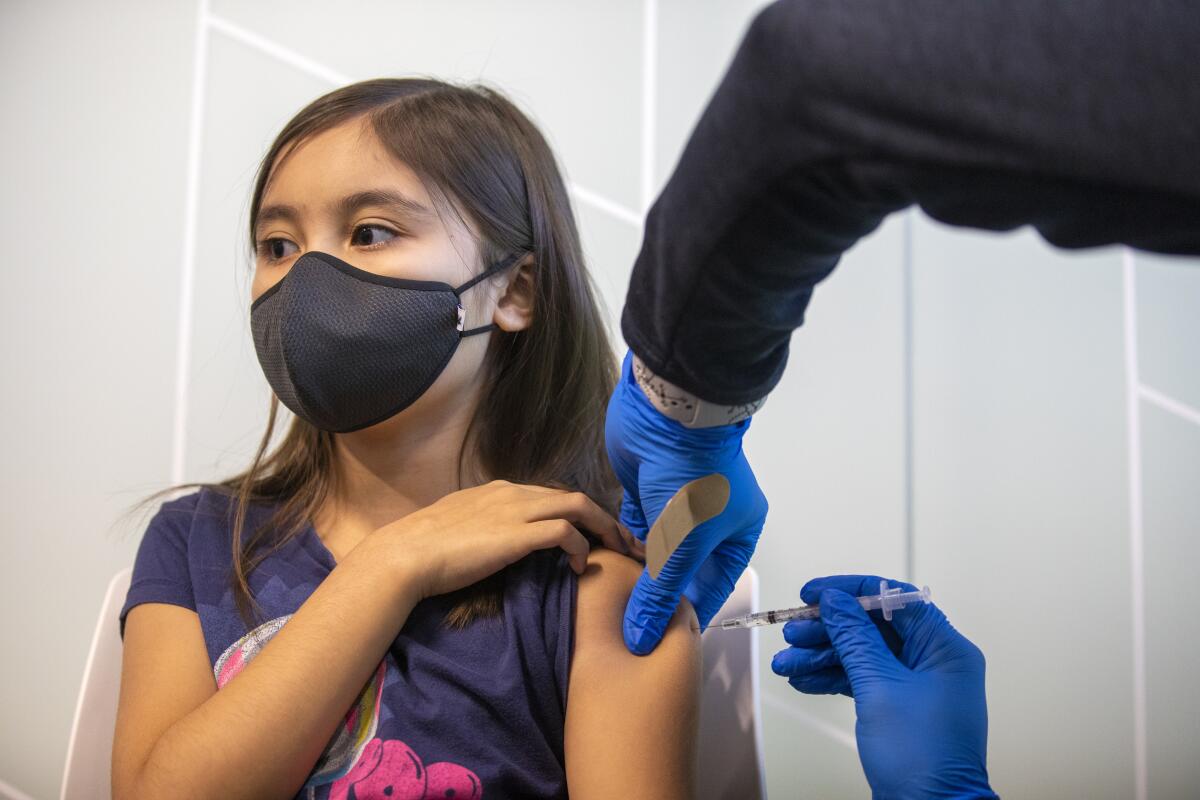
Despite months of outreach and on-the-ground efforts, the COVID-19 vaccination campaign for young children remains stuck in neutral — prompting experts to say more needs to be done to inform parents about the benefits of inoculation.
In California, just 34% of children age 5 to 11 have completed their primary vaccination series, compared with 66% of youths age 12 to 17, according to state health data compiled by The Times.
By contrast, 78% of younger adults up to age 49 have completed their primary vaccination series, while at least 83% of older adults have done so.
The California Department of Public Health on Friday announced a $10-million grant program aimed at incentivizing healthcare providers to extend their operations to make pediatric vaccinations more easily attainable for families.
“Vaccines are the most powerful tool we have to protect our children and our communities from the dangers of COVID-19,” California Health and Human Services Secretary Dr. Mark Ghaly said in a statement. “This grant program will make COVID-19 vaccines more accessible to children and their families by recruiting new providers and supporting existing providers by expanding operating hours. As a father and a pediatrician, I assure you COVID-19 vaccines are safe and effective. Please make an appointment to get your family vaccinated today.”
Here’s what you need to know amid a holiday season — including Easter, Ramadan and Passover — spring break and events like Coachella and Stagecoach.
Here are six reasons why parents should get their children vaccinated, according to Dr. Mark Sawyer, a clinical pediatrics professor and pediatric infectious disease specialist at the UC San Diego School of Medicine and Rady Children’s Hospital San Diego.
Sawyer is also on the Food and Drug Administration’s vaccines advisory committee, which plays a major role in advising the federal agency on new vaccines. He made the following points at a recent briefing the California Medical Assn. provided to the state’s physicians:
Children COVID-19 hospitalization rates are higher than that for the flu
Sawyer cited data showing the cumulative rate of COVID-19 hospitalizations for children under age 18 are higher than what’s typical for the flu.
As of mid-August, there were about 50 COVID-19 hospitalizations for every 100,000 children under age 18 since the beginning of the pandemic.
Over the same time period, there would be typically roughly between 10 and 25 hospitalizations for the flu for every 100,000 children, according to data Sawyer presented.
“COVID is putting a lot more kids in the hospital than influenza does — and that’s a vaccine that we routinely use in children,” Sawyer said.
Data show that for the seven-day period that ended Monday, an average of 960 new cases were reported daily countywide, which pencils out to 67 cases a week for every 100,000 residents. That’s up 23% from the previous week.
Thousands of children have become seriously ill with MIS-C
In children nationally, data show there had been more than 6,800 cases of multisystem inflammatory syndrome — a rare but serious inflammatory condition associated with COVID-19 — through the end of January, 59 of which resulted in death.
In California, there have been more than 900 cases of MIS-C, with at least eight children dying from the syndrome. Half of those diagnosed with MIS-C have needed care in the intensive care unit, said state epidemiologist Dr. Erica Pan.
The age group most likely to suffer from MIS-C are children age 5 to 11, Sawyer said.
Symptoms of MIS-C include fever that does not go away and inflamed body parts, including the heart, lungs, kidneys, brain, skin, eyes or gastrointestinal organs.
Vaccination reduces the chance of suffering from MIS-C. A report published by the Centers for Disease Control and Prevention in January found that two doses of the Pfizer-BioNTech vaccine was 91% effective against contracting MIS-C.
“Among critically ill MIS-C case-patients requiring life support, all were unvaccinated,” the report said.
As government agencies have cast off pandemic protections, many immunocompromised and disabled people have felt forgotten.
COVID-19 is associated with a greater risk of getting diabetes
Adults who have survived a coronavirus infection have a higher chance of getting diabetes, and the same is true for children, Sawyer said.
A report published by the CDC in January said that children who have had COVID-19 were more likely to receive a new diabetes diagnosis more than a month after a coronavirus infection than those who never were infected.
“I don’t think we completely understand why that’s happening. But clearly this phenomenon is holding up over time,” Sawyer said.
The vaccines work to protect against severe illness
COVID-19 vaccinations for children are protective against severe illness and hospitalization, studies show.
One of the latest studies, published by the New England Journal of Medicine, showed that vaccination reduced the risk of Omicron-associated hospitalizations by two-thirds among children age 5 to 11.
Vaccination also prevented critical illness by either the Delta or Omicron variant among those age 12 to 18, the report said.
Lawmakers dropped nearly all funding for curbing the coronavirus beyond U.S. borders. Experts say that’s short-sighted.
Data mount on vaccine safety
Millions of doses of vaccines have been given to children, and the data are only growing showing the safety of vaccines, according to Sawyer.
No vaccines in current use have ever been shown to cause long-term harmful side effects that present themselves years after vaccination, Sawyer said.
The only significant side effect that has been noted in children following vaccination is myocarditis, an inflammation of the heart, but those symptoms develop in the weeks following vaccination, he added.
The symptoms of post-vaccination myocarditis are also rare and mild, Sawyer said. Health officials have previously said post-vaccination myocarditis usually results in minor symptoms that last only a couple of days and can be treated with Motrin.
Citing data published in a preprint report, recovery from post-vaccination myocarditis typically happens in a matter of days, while myocarditis that occurs from MIS-C or a classic kind of myocarditis caused by other viral infections can generally last much longer.
Speaking of post-vaccination myocarditis, “most kids recover completely in just a few days,” Sawyer said.
Data are mounting that the risk of developing myocarditis from a coronavirus infection is much higher than from the vaccine.
A report published by the CDC found that boys age 12 to 17 had two to six times the risk of heart complications after infection compared with after vaccination.
“COVID-19 vaccination is the best way to protect against COVID-19 and rare heart complications,” the report said.
Projections presented to federal scientific advisors this year showed that among younger adults up to age 39, for every million second doses of the Moderna vaccine issued, about 3,000 coronavirus-associated hospitalizations were expected to be averted, while 33 cases of post-vaccine myocarditis were expected.
“There’s just no comparison: You are much more likely to get in trouble from a cardiac point of view if you get infection than if you get vaccination,” Sawyer said.
“The vaccines are both safe and effective,” Sawyer said.
Hospitalization rates have jumped significantly for the youngest children in the Omicron era
Children younger than age 5 aren’t yet eligible for vaccination yet, but there is a need for them to get protected with vaccination, according to data Sawyer presented.
The Omicron variant has led to a substantial number of younger children age 4 and under getting put into the hospital because of COVID-19, Sawyer said. Hospitalization rates among children in this age group rose to their highest rates of the entire pandemic.
Sawyer cited a study published by the CDC in March that found that weekly COVID-19 hospitalization rates among children age 4 and younger were five times as high during the peak of the Omicron surge compared with Delta.
For every 100,000 children in this age range, 14.5 were hospitalized for the week of Omicron’s peak, compared to 2.9 during the week of Delta’s peak.
When Omicron dominated, 63% of hospitalized infants and children in this age group had no underlying medical conditions.
“This is an illness that affects healthy children,” Sawyer said. “A lot of healthy kids get hospitalized.”
The overwhelming majority of coronavirus-positive children in this age group who were hospitalized were primarily being treated for their COVID-19. “This is not a phenomenon where kids are being put in the hospital for other things and just incidentally have a positive test,” Sawyer said.
What do parents think?
Boosting child vaccination rates to more robust levels may prove to be a hard sell, however. In a poll published last month as part of its COVID-19 Vaccine Monitor project, the Kaiser Family Foundation found that 30% of respondent parents with children between the ages of 12 and 17 would definitely not get their charges vaccinated, while 3% would do so only if required.
Resistance was more pronounced among those with children age 5 to 11, with 36% of parents saying they would definitely not get their youngsters vaccinated and another 11% saying they would do so only if required.
California has not yet implemented rules that would eventually require COVID-19 vaccinations as a condition for attending seventh to 12th grades in public and private schools.
For that to happen, the FDA would have to grant full approval to a COVID-19 vaccination series for children ages 12 to 15. The vaccines are currently available for that age group under an emergency use authorization.
More to Read
Sign up for Essential California
The most important California stories and recommendations in your inbox every morning.
You may occasionally receive promotional content from the Los Angeles Times.

